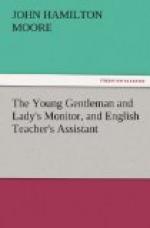Great care must he taken that the pupil end one sentence completely, before he begin another. He must let the arm drop to the side, and continue for a moment in that posture in which he concluded, before he poizes his body on the other leg, and raises the other arm into the diagonal position before described; both which should be done before he begins to pronounce the next sentence. Care must also he taken in shifting the body from one leg to the other, that the feet do not alter their distance. In altering the position of the body, the feet will necessarily alter their position a little; but this change must be made by turning the toes in a somewhat different direction, without suffering them to shift their ground. The heels, in this transition, change their place, but not the toes. The toes may be considered as pivots, on which the body turns from side to side.
If the pupil’s knees are not well formed, or incline inwards, he must be taught to keep his legs at as great a distance as possible, and to incline his body so much to that side, on which the arm is extended, as to oblige him to rest the opposite leg upon the toe; and this will, in a great measure, hide the defect of his make. In the same manner, if the arm be too long, or the elbow incline inwards, it will be proper to make him turn the palm of his hand downwards, so as to make it perfectly horizontal. This will infallibly incline the elbow outwards, and prevent the worst position the arm can possibly fall into, which is that of inclining the elbow to the body. This position of the hand so necessarily keeps the elbow out, that it would not be improper to make the pupil sometimes practice it, though he may have no defect in his make; as an occasional alteration of the former position to this, may often be necessary both for the sake of justness and variety. These two last positions of the legs and arms, are described in plate second.
When the pupil has got the habit of holding his hand and arm properly, he may be taught to move it. In this motion he must be careful to keep the arm from the body. He must neither draw the elbow backwards, nor suffer it to approach to the side, bur, while the hand and lower joint of the arm are curving towards the shoulder, the whole arm, with the elbow forming nearly an angle of a square, should move upwards from the shoulder, in the same position as when gracefully taking off the hat; that is, with the elbow extended from the side, and the upper joint of the arm nearly on a line with the shoulder, and forming an angle of a square with the body—(see plate III.) This motion of the arm will naturally bring the hand with the palm downwards, into an horizontal position, and when it approaches to the head, the arm should with a jerk be suddenly straitened into its first position, at the very moment the emphatical word is pronounced. This coincidence of the hand and voice, will greatly enforce the pronunciation; and if they keep time, they will be in tune as it were to each other, and to force and energy add harmony and variety.




